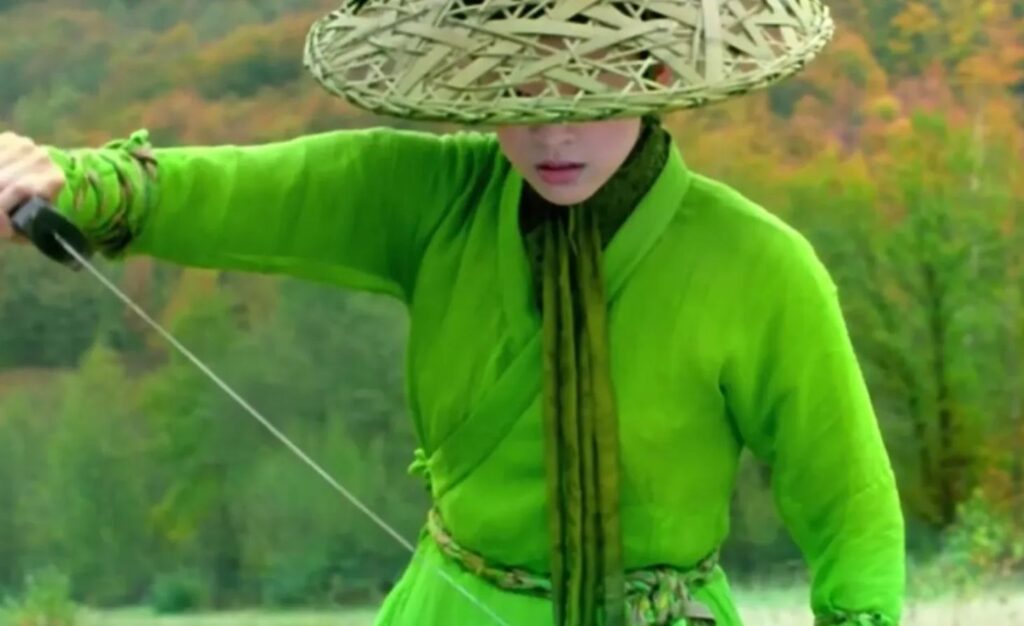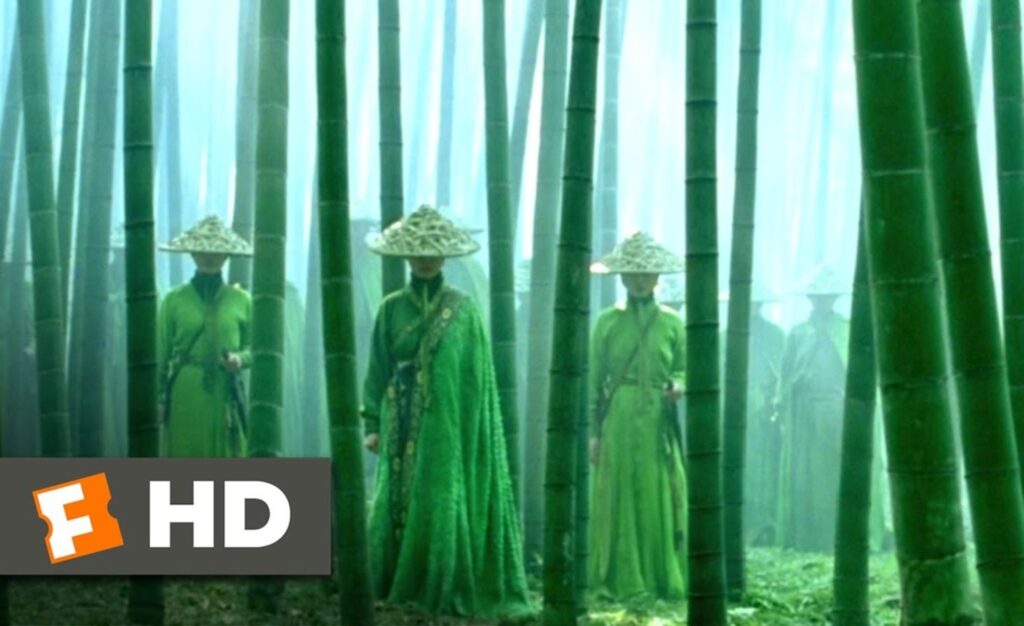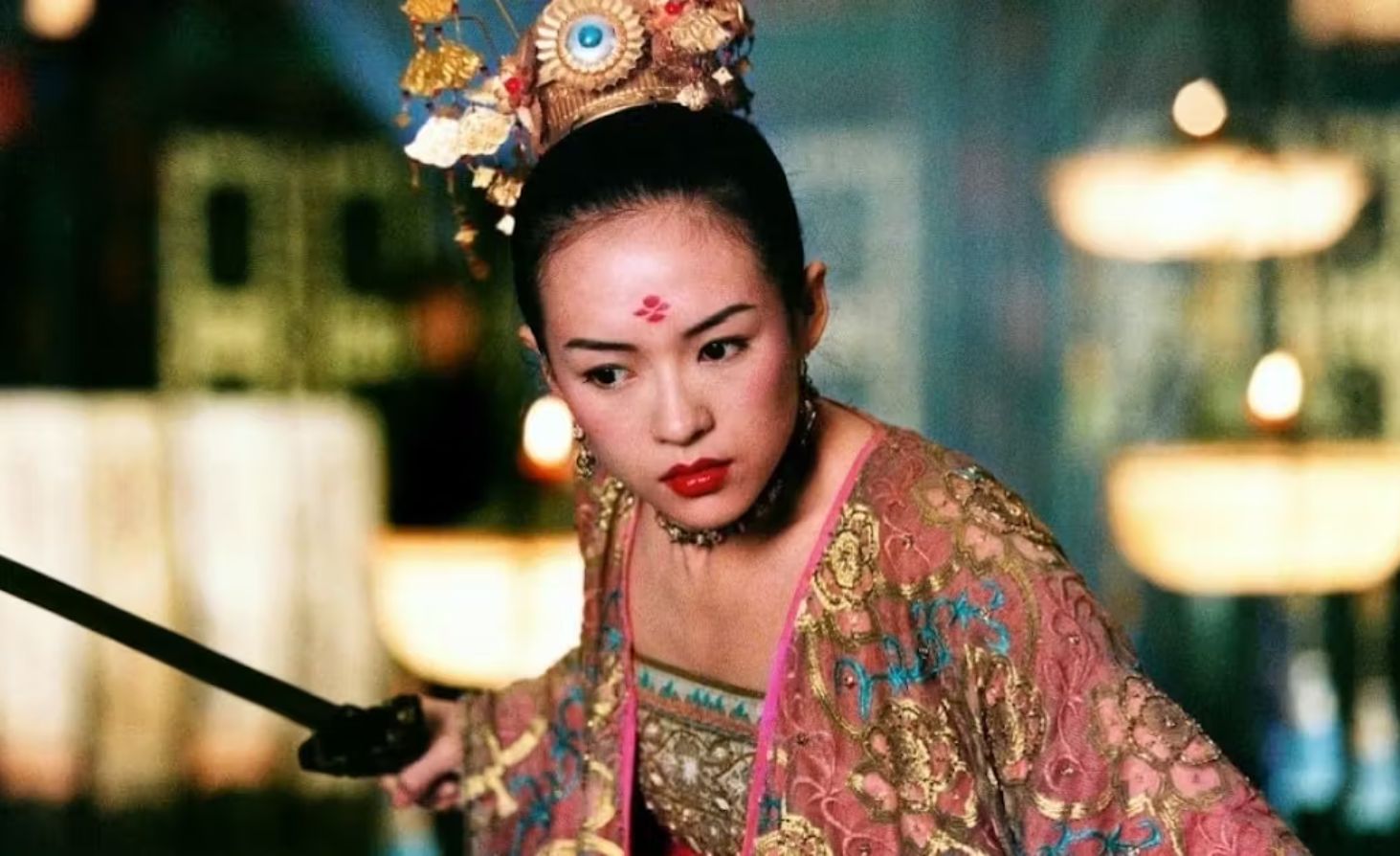Introduction
The dummy sequence from House of Flying Daggers is one of the most captivating scenes in martial arts movies. The film, which was directed by Zhang Yimou, has received praise for its poetic storytelling, emotional depth, and stunning vistas. Nonetheless, the dummy scene is one of its many memorable moments. It’s not simply an exciting demonstration of fighting prowess; it’s a masterfully staged scene with deep symbolic meaning. Aspects of the characters’ inner lives are revealed with each movement and strike, which also subtly allude to the plot’s development. It’s more than just a fight; it’s a dance of elegance, suspense, and unsaid truth—a potent fusion of storytelling and artistic expression that perfectly embodies what House of Flying Daggers stands for.
The Symbolism Behind the Dummy Scene
The dummy scene exemplifies how action may function as metaphor in Zhang Yimou’s storytelling, which is renowned for incorporating deeper meaning into every frame.
An Example of Inner Power
In this instance, Mei becomes a representation of inner strength while wearing a blindfold and being led solely by sound and instinct. More than just a demonstration of her fighting prowess, her ability to hit each drum blindly is a testament to her emotional fortitude, instinct, and trust. It serves as a reminder to viewers that inner strength frequently stems from feelings and beliefs rather than external manifestations.
Keeping Beauty and Violence in Check
Mei’s assignment is hitting wooden dummies, which seems like a cruel and violent act, but it is depicted with amazing grace. Her precise and rhythmic movements turn a punishing workout into something nearly poetic.The film’s overarching theme—that beauty can arise even in times of conflict—is reflected in this balance between force and elegance.
A Sneak Peek at Upcoming Conflicts
In addition to being aesthetically stunning, the moment gently foreshadows the emotional connections that will ultimately propel the narrative. The betrayals, shifting allegiances, and complex relationships that are to come are hinted at by the subdued tension, adoration, and unspoken bond between people throughout this scene. What starts out as a skill test develops into a multi-layered sneak peek at the emotional journey that lies ahead.
Choreography and Cinematic Techniques
House of Flying Daggers’ fake scene is a remarkable example of technical expertise, with all the components—from sound and design to camera work—combined to enhance the narrative.
Work with Dynamic Cameras
The camera takes on the role of an active participant rather than merely recording the activity. Intimate close-ups show Mei’s focus and inner resolve, while sweeping wide shots capture the entire choreography and let spectators admire the accuracy of every step. Each blow becomes a visual declaration of power and emotion thanks to the use of slow motion, which accentuates moments of flawless synchronization.
Immersion Music and Sound
In this sequence, sound is essential. The audience’s tension is synchronized with Mei’s rhythm as each drumming reverberates across the room like a pulse. Suspense is created by the contrast between purposeful silences and piercing, resonant blows, which makes the scenario as much an audio as a visual one. This rhythm is smoothly supported by the music, which heightens the emotional pull without taking away from the action.

Using Symbols in Set and Costume Design
The scenario is a masterwork of contrast in terms of visuals. The circle of wooden dummies symbolizes both difficulty and restriction, while Mei’s flowing clothing gives her movements a lovely, almost dance-like flexibility. A powerful metaphor—grace and humanity triumphing over stiffness and control—is created by the vivid cloth contrasted with the subdued set colors.
Character Development Through the Dummy Scene
The dummy scene is more than just a visually spectacular performance; it marks a shift in the audience’s perception of the main characters and their interactions.
Mei’s Development into a Real Warrior
Mei is presented in this scene as much more than just a graceful performance; rather, she is shown to be a strong, accurate, and silent woman of will. Her poised completion of the blindfolded test highlights her depth as a talented, enigmatic, and disciplined person. She gains not only acclaim as a dancer but also as a talented fighter with inner strength via this scene.
The Observant Role of Jin
Although Mei directs the action, Jin’s spectator role provides emotional depth. His observant gaze exudes appreciation, interest, and a growing fascination. As Jin observes Mei’s power, a bond is formed between them that foreshadows the complex relationship and tension that will develop. His viewpoint serves as a reminder to viewers that this is a time of human connection and discovery rather than just a test of talent.
Authority and the Testing Theme
The staging of the situation, which is supervised by powerful people, turns it into a symbolic trial. Mei’s performance serves as an evaluation of her loyalty and credibility in addition to being a showcase for her talent. Throughout the movie, the idea of “testing” appears frequently, symbolizing how identity, trust, and truth are continuously questioned in both romantic and combat situations.
Lasting Impact on Martial Arts Cinema
One of the most recognizable scenes in martial arts movies is the dummy scene. Because it reimagines what an action sequence may be, turning physical conflict into a visual language of emotion, symbolism, and narrative, it has a lasting impression.The scene defied convention by fusing movement and meaning, demonstrating that battle choreography can function as both art and narrative.

In addition to its technical mastery, the scene demonstrated to viewers around the world the complexity of Chinese wuxia. It demonstrated how martial arts, in this culture, are manifestations of beauty, philosophy, and inner power rather than merely being instruments of violence. Many viewers were introduced to a cinematic style where action is laced with poetry by the scene’s delicate yet tense equilibrium.
The dummy scenario is still relevant years after it was first released. While fans repeat it as a standard of artistic storytelling, film academics examine it for its workmanship and meaning. Its legacy lives on as a brilliant illustration of how one masterfully composed moment can revolutionize a genre and serve as an inspiration to future generations of filmmakers.
Facts:
- Film Title: House of Flying Daggers (2004)
- Director: Zhang Yimou — renowned for visually poetic films like Hero and Raise the Red Lantern.
- Genre: Wuxia (a Chinese genre blending martial arts, fantasy, and philosophical themes).
- Main Character in Scene: Mei (played by Zhang Ziyi).
- Setting: A circular room with wooden dummies and drums used as part of a blindfolded test.
- Purpose of Scene:
- To test Mei’s skill, loyalty, and intuition.
- To symbolically explore themes of inner strength, trust, and balance between beauty and violence.
- To test Mei’s skill, loyalty, and intuition.
- Cinematic Techniques Used:
- Dynamic camera work (close-ups and sweeping shots).
- Slow motion to emphasize precision.
- Sound design that mirrors Mei’s heartbeat-like rhythm.
- Dynamic camera work (close-ups and sweeping shots).
- Symbolism:
- Blindfold: Trust and inner vision.
- Drums/Dummies: Barriers, tests, and echoes of fate.
- Circular formation: Confinement, destiny, and cyclical struggle.
- Blindfold: Trust and inner vision.
- Key Themes: Inner strength, resilience, love, testing of loyalty, and poetic conflict.
- Legacy: The scene is widely regarded as one of the most artistically choreographed martial arts sequences ever filmed and is studied in film schools for its fusion of visual art and storytelling.
Summary
The dummy scene from House of Flying Daggers is a landmark in martial arts cinema, blending beauty, emotion, and symbolism in a single mesmerizing sequence. Directed by Zhang Yimou, the scene showcases Mei, a blindfolded dancer-warrior, as she uses sound and intuition to strike drums and wooden dummies with precision and grace.
This test is more than a display of martial skill—it reflects Mei’s inner strength, emotional balance, and trust in instinct. The fluid choreography transforms violence into poetry, symbolizing the film’s broader themes of beauty within conflict. Meanwhile, Jin’s role as an observer adds emotional depth, hinting at future bonds and betrayals.
Technically, the scene is a cinematic masterpiece, using immersive sound, rhythmic pacing, and vivid costume contrast to enhance its visual storytelling. Beyond aesthetics, it represents Zhang Yimou’s ability to turn action into metaphor, portraying martial arts as a language of the soul rather than mere combat.
Even decades later, the dummy scene remains a touchstone of wuxia cinema, inspiring filmmakers and audiences worldwide for its seamless blend of art, philosophy, and action.
FAQs:
1. What is the purpose of the dummy scene in House of Flying Daggers?
The scene serves as a test of Mei’s skill, loyalty, and intuition while symbolizing her inner strength and resilience. It also foreshadows emotional tensions and shifting alliances later in the film.
2. Why is Mei blindfolded during the scene?
The blindfold represents trust, instinct, and inner vision, reinforcing the idea that true strength and understanding come from within, not just from sight.
3. How does Zhang Yimou use cinematography in this scene?
Zhang uses sweeping shots, close-ups, and slow motion to highlight the precision of Mei’s movements and to turn the choreography into a form of visual poetry.
4. What makes this scene different from typical martial arts sequences?
Unlike conventional fight scenes focused on violence, this sequence emphasizes elegance, rhythm, and symbolism, blending combat with dance-like beauty and emotional storytelling.
5. What is the symbolic meaning of the dummies and drums?
The dummies represent challenges, obstacles, and fate, while the drums symbolize rhythm, control, and emotional heartbeat, connecting Mei’s inner world to the external test.
6. How does this scene contribute to Mei’s character development?
It introduces Mei as a multidimensional figure—not just a performer, but a warrior with strength, discipline, and emotional depth, setting the tone for her arc in the film.
7. What legacy did this scene leave in cinema?
The dummy scene is regarded as a milestone in wuxia filmmaking, influencing later directors to incorporate symbolism, artistry, and emotion into martial arts choreography.
8. Why is sound design so important in this sequence?
Because Mei relies on sound to fight, the rhythmic drumming and strategic silences create suspense and emotional intensity, immersing the audience in her perspective.
9. How does the scene reflect Zhang Yimou’s filmmaking style?
It encapsulates Zhang’s trademark blend of visual grandeur, emotional subtlety, and layered symbolism, where every gesture carries narrative significance.
10. What message does the dummy scene leave with the audience?
It reminds viewers that true mastery lies in balance—between strength and grace, sight and intuition, beauty and conflict—echoing the film’s deeper philosophical themes.
Read More About Blog spotwave

